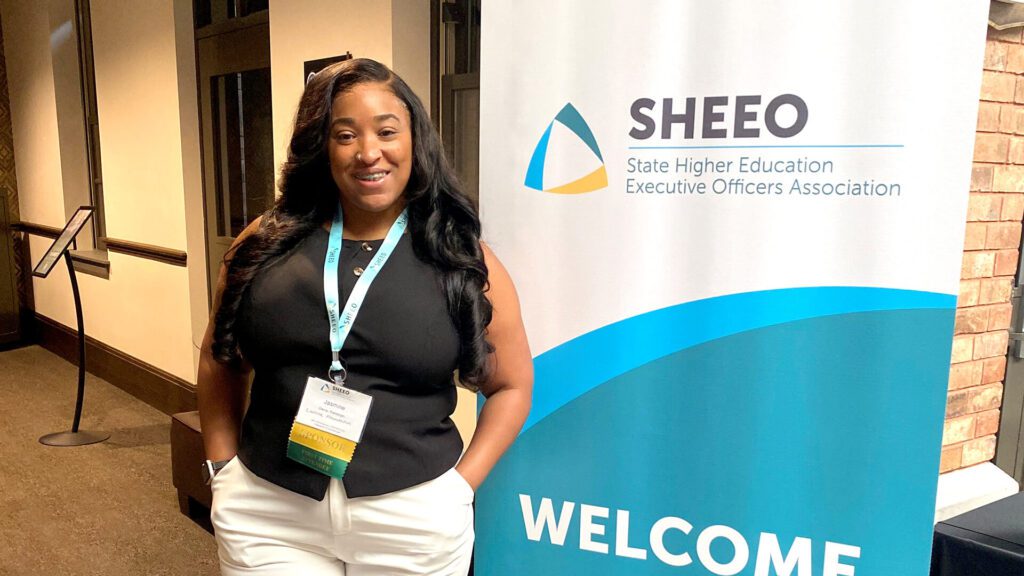Reflections on data gaps, the value of college, and how we can move forward together
Higher education is navigating unprecedented times marked by misinformation, public skepticism, and structural change. The State Higher Education Executive Officers Association (SHEEO) meeting is critical for uncovering important research and practical strategies to help institutions maneuver through this shifting landscape.
As the new strategy officer for research at Lumina Foundation and someone new to the world of philanthropy, I recently attended my first SHEEO meeting. This year’s policy conference in Minneapolis was a valuable introduction to understanding how philanthropic efforts can support new pathways for U.S. students. But learning this landscape meant confronting just how much of it is shifting beneath us. My first steps into SHEEO felt like stepping onto shaky ground.
One very clear lesson emerged: Our colleges and universities will only stay relevant if we critically rethink the higher education experience to meet the needs of a changing world. Even on shaky ground, we must continue to clear out what no longer works, take care of what we have, and make space for new growth. Progress isn’t always about moving forward. Like tending a garden, sometimes it’s about maintaining, protecting, and preparing the ground for what’s next. It’s in this kind of unsettled but potential-filled “soil” that some of higher education’s hardest questions are taking root.
What the data misses, and where to look next
I heard a common theme in many of the conversations I joined: the numbers don’t seem to reflect reality.
There is tension between what research tells us about the value of a degree and how that value is perceived by students, families, and society at large. Some attendees raised important questions: Is this simply a data issue? Or is it a reflection of deeper misalignment?
A couple of explanations stood out to me:
- Data coverage gaps. Current collection methods can exclude key groups, which skews the picture toward those who experience higher returns from college and too few of those with mixed outcomes. These gaps can distort our understanding of value.
- Delayed evidence. Education data and analysis often trail current trends. By the time we capture the impact of market shifts, students have already moved through the system. This lag makes our data less reflective of real-time experiences.
Redefining value in a changing world
Another tension that surfaced was how we define the value of higher education. Too often, the conversation gets narrowed to post-graduation income, but value looks very different depending on institution type, degree path, region, and individual circumstances.
One example cited was K-12 teachers, specifically in rural locations. Although their salaries might not show a strong financial return, they’re essential for those communities and their students.
Some conversations reframed value beyond dollars. We see this broader view of value in research Lumina supports, such as Harvard’s The Good Project, which examines how students and professionals define the value of higher education through social contribution, and ethical responsibility. We also support research that elevates how we measure and communicate the public returns of postsecondary education, including an open innovation challenge on the Wazoku InnoCentive platform to crowdsource new metrics and data sources.
This builds on earlier work, including the 2023 Gallup Education for What? report, which linked higher education to better income, health, civic engagement, and wellbeing across 50 of 52 outcomes. These aren’t new questions for us at Lumina, and we’ve often explored them in staff blogs and commentary on value, quality, and equity in higher education.
Solutions for today’s students and tomorrow’s
Several conversations at SHEEO centered on how closer partnerships with employers could help redefine what a return on investment really means.
We’re already seeing this in practice through Lumina-supported efforts like Talent Pipeline Management, led by the U.S. Chamber of Commerce Foundation and adopted in states like Kentucky, Michigan, Alabama, and Vermont. In this project, employers and educators co-design pipelines and measure ROI through outcomes such as job placement, retention, and workforce diversity.
But there was also a note of caution. We must not limit our vision to only current labor market needs. We must support today’s learners while preparing them for future opportunities by building systems that enable long-term mobility and adaptability.
Moving forward in a changing landscape
Leaving SHEEO, I didn’t come away with easy answers. I came away with sharper questions, and that’s the point.
Redesigning systems, reframing value, and closing data gaps aren’t tasks for one meeting, one person, or one institution. SHEEO offers space to ask these critical questions together and turn them into shared action.
Now is the season for preparation. What grows next depends on how we nurture the ground beneath us, and I’m ready to be a part of that work.
[Jasmine Davis-Randolph, Ph.D. is the strategy officer for research at Lumina Foundation, an independent foundation that helps Americans keep learning beyond high school. She works across strategy areas, managing grants and synthesizing key learnings. She joined Lumina from the American Institutes for Research, where she co-led studies on topics such as community college retention and credentials of value. Her academic research aims to create opportunities for those who have been historically left out. Learn more about SHEEO, its members, and goals.]

